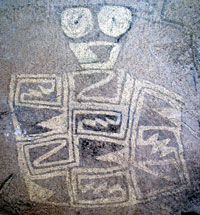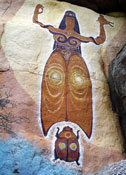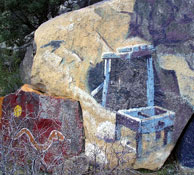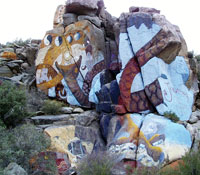|
Rock
Art
Archaeologists, anthropologists, and historians know that prehistoric people did not spend all their time finding and collecting food. For many nomadic hunter-gatherers and later agricultural societies, food sources were abundant. Their lives allowed free-time to play games, to tell stories and socialize with their family groups, and to create. Prehistoric people used rock for tools, but also as a medium for artistic communication and expression. Many examples of prehistoric rock art survive today. Ancient rock art is found around the world and can be attributed to many different cultures. Cave pictures such as those found at Lascaux, France (c. 15,000 - 10,000 BC) and Altamira, Spain display animals and hunt scenes. This rock art is not ancient grafitti. These people did not have an alphabet, paper, pen or pencils, cameras, or any other way to record their beliefs and experiences. The rock art tells us stories, reveals traces of their religious beliefs and ceremonies, and relates some of the history of the people who created the images. |
|||||||||||
|
Southwestern US Rock Art Ancient rock art can also be found everywhere in North America. Tens of thousands of rock art sites are found in the Southwest (Arizona, California, Colorado, Nevada, Texas, Utah, and New Mexico), over 7,500 sites in Utah alone. The mysterious images and markings that were pecked or painted on boulders and cliffs are referred to as primitive art; however, they are also communication efforts. Their messages convey a mental image from one mind to another, similar to today's road signs, trademarks, cartoons, advertisments, and other symbols. These ancient images - - symbols of their times - - are found above stone shelters, inside caves or ceremonial rooms, alongside watering places, near game trails, at food gathering spots, and near cultivation areas. |
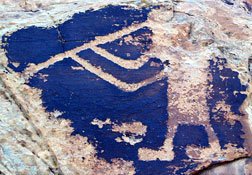 |
||||||||||
|
|||||||||||
|
Reasons for their creation could have included marking territory; depicting shamanic prayers or visions; recording rituals, successful hunts and battles; ensuring rain, harvests, and fertility; creating designs for pleasure, or chronicling human presence. Whatever the purpose, these artifacts provide a visual record from ancient societies. Pictograph or Petroglyph - What's the Difference? There are two types of pictured rocks: petroglyphs and pictographs. Confusingly, some experts classify both petroglyphs and pictographs as being pictographs - - that is, they recognize the term pictograph to include both pictographs and petroglyphs. If we can get past that, lets concentrate on separating the two types or techniques. Petroglyphs are motifs that are pecked, ground, incised, scratched, or abraded into the rock surface. The name petroglyph is Greek with petro referring to rock and glyph meaning drawing or engraving. Many of them were executed on cliff faces or boulders that were covered in 'rock varnish' (Above right photograph). In a few locations, you can find petroglyphs on an unvarnished rock surface - - an 'intaglio' design that is carved directly into the rock (Example: Inscription Rock shown below). In both instances, rock tools were used to dent, chisel, or chip the images into the stone canvas. |
|||||||||||
|
|
|||||||||||
|
Ancestral
Puebloan petroglyph, 'Inscription Rock', El Morro National Monument,
New Mexico
|
|||||||||||
|
|
The other type of rock art, pictographs are paintings or drawings made on rock. They were completed in one or more colors using mineral pigments and natural dyes from plants. Because of their relative ease of creation, pictographs tend to contain more complex designs than petroglyphs (Photo on left). However pictographs are also more fragile works of art. Few survive today unless they are located in sheltered areas such as underneath rock overhangs and recessed within alcoves. Many rock art images were originally executed using a combination of both techniques; however, most are seen today as petroglyphs only because the paint material has faded, flaked, or washed away. Look closely, you might be able to see a faint painted design that accompanied the 'pecked' image before most of it weathered away.. | ||||||||||
|
Ancestral
Puebloan pictograph, Tlaloc Figure
|
|||||||||||
| Hueco Tanks Historical Park, El Paso Co. Texas | |||||||||||
|
Cultures, Styles, and Age of Rock Art One can find many different cultures represented in Southwestern US rock art sites; however, four groups of peoples are most prevalent (Dates shown are approximate).
|
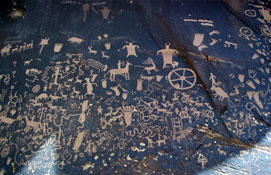 |
||||||||||
|
Newspaper
Rock State Historic Site. SE Utah
|
|||||||||||
| Rock drawing did not cease with the arrival of Europeans. In fact, they supplied new and interesting subjects: horses, hats, wheels. Some rock art sites have been used for thousands of years by different cultures, predecessors of today's Indians. One such site is 'Newspaper Rock,' located near Canyonlands in southeastern Utah. There etched in the dark patina of a heavily varnished slab of rock are hundreds of figures from a number of cultures - Archaic, ancestral Puebloan, Fremont, Ute and Navajo historic tribes, as well as Anglo-American (Photo above right). The huge panel is protected from the elements by a natural overhang that has saved it from everything except contemporary vandalism. Today a security railing and shield have been erected to halt further unnatural damage. | |||||||||||
|
Southwestern rock art is often composed of anthropomorphs (human-like figures), zoomorphs (animal-like figures), and abstract designs. Other image types are found including body parts such as hands and feet, plants, masks, shields, and maplike images. It is difficult to establish the exact age of rock art. In some instances, dating clues are easily identified. The presence of bows and arrows indicate a date after 500 AD. If a horse and rider are shown, it is known to be after 1540 AD when Spaniards reintroduced the horse. |
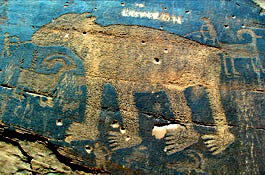 |
||||||||||
|
Potash
Road (Hyway 279), Near Moab, Utah
|
|||||||||||
|
In most cases, other techniques are used to give an approximate age of the rock art:
|
|||||||||||
 |
Rock Art of Today The painting and carving of images onto rock surfaces continues today. The work of amateur (Photo on left) and professional folk artists can be found in shops and at craft fairs. In the Southwest, one can locate descendants of ancient tribal people who are creating and selling rock art that is reminiscent of ancient pictographs and petroglyphs. The three photographs (Below) show Navajo folk artists, Antonio C. and D. Denny, Chinle, Arizona, and their artwork. |
||||||||||
 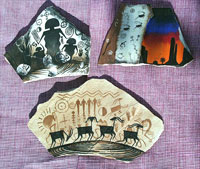 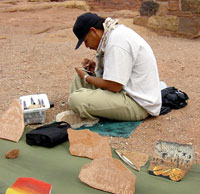 |
|||||||||||
| In
the foothills near the historic mining town of Chloride
in northeastern Arizona are the rock
murals of well-known artist Roy Pucell (See photos below). These unusual
examples of modern rock art were created in 1960s by the artist, then
an unknown graduate student and also a working miner in that area. The
artwork includes scenes of weathered buildings, ghost towns, landscapes,
and symbolic figures. The Murals have held up well through the years and
the colors remain vibrant even after almost forty years. Curiously if
one searches nearby, you find a few weathered and faded petroglyphs from
hundreds of years before.
More Information Rock art sites are found on private, state, federal, and Native American tribal lands. All ancient rock art sites are protected areas; that is, federal laws are enforced to protect them from theft, defacement, and vandalism. Take care of them. The sites are extremely fragile. Once damaged, the site cannot be restored to its original condition. Never touch the rock surfaces. Oils from your skin chemically alter the surface and also attract insects and animals. Do not make chalk rubbings or try to change the images in any manner. Take care when walking around rock art sites; avoid treading on panels that you did not notice. For additional information about rock art, pictographs, and petroglyphs, visit some or all of these websites:
Try a webquest activity. Note:
All photographs were taken with a digital camera in Arizona, New Mexico,
Texas, and Utah. |
|||||||||||

